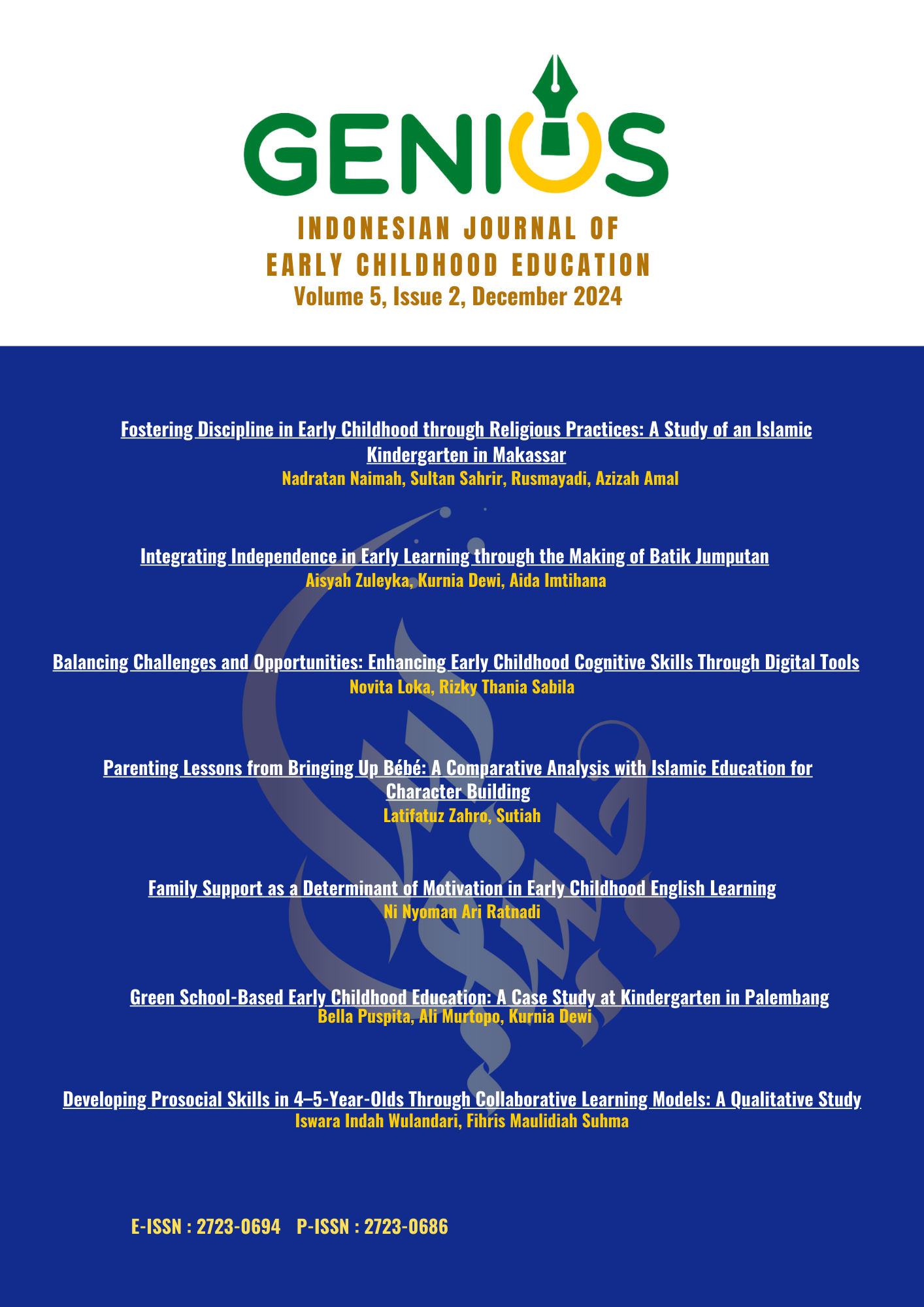Balancing Challenges and Opportunities: Enhancing Early Childhood Cognitive Skills Through Digital Tools
DOI:
https://doi.org/10.35719/gns.v5i2.187Keywords:
early childhood education, cognitive development, digital toolsAbstract
This study investigates the role of digital tools, particularly educational videos, in enhancing early childhood cognitive skills at Pertiwi Indralaya Kindergarten. Using a qualitative descriptive approach based on the Miles and Huberman framework, data were collected through classroom observations, interviews, and documentation involving 20 children aged 4–5. Findings reveal that 55% of students exhibited "Very Well Developed" cognitive skills, while 45% were "Developing as Expected," with no children in lower categories. Key cognitive areas improved included problem-solving, memory retention, and logical reasoning, supported by a balanced integration of digital and traditional learning methods. Challenges such as maintaining focus and avoiding screen dependency underscore the need for structured guidance. The study concludes that combining digital and conventional strategies can foster cognitive development, highlighting the importance of teacher facilitation and responsible technology use in early childhood education.
References
Anggita, I. S., Yusuf, H., Naimah, N., & Putro, K. Z. (2022). Pedoman literasi digital guru untuk meningkatkan kemampuan kognitif anak usia dini. Jurnal Obsesi : Jurnal Pendidikan Anak Usia Dini, 6(5), 4697-4704. https://doi.org/10.31004/obsesi.v6i5.2752
Barr, R., & Kirkorian, H. (2023). Reexamining models of early learning in the digital age: Applications for learning in the wild. Journal of Applied Research in Memory and Cognition, 12(4), 457–472. https://doi.org/10.1037/mac0000132
Basyir, M. S., Dinana, A., & Devi, A. D. (2022). Kontribusi teori belajar kognitivisme David P. Ausubel dan Robert M. Gagne dalam proses pembelajaran. Jurnal Pendidikan Madrasah, 7(1), 89–100. https://doi.org/10.14421/jpm.2022.71.12
Charan, G. S., Kalia, R., Khurana, M. S., & Narang, G. S. (2024). From Screens to Sunshine: Rescuing Children’s Outdoor Playtime in the Digital Era. Journal of Indian Association for Child and Adolescent Mental Health, 20(1), 11–17. https://doi.org/10.1177/09731342241229845
Dogan, S., Dogan, N. A., & Celik, I. (2021). Teachers’ skills to integrate technology in education: Two path models explaining instructional and application software use. Education and Information Technologies, 26(1), 1311–1332. https://doi.org/10.1007/s10639-020-10310-4
George, S. (2019). Games, Simulations, Immersive Environments, and Emerging Technologies. In A. Tatnall (Ed.), Encyclopedia of Education and Information Technologies (pp. 1–10). Springer International Publishing. https://doi.org/10.1007/978-3-319-60013-0_36-1
Goode, K., & Vasinda, S. (2021). Videogames and Sensory Theory: Enchantment in the 21st Century. In L. Haas & J. Tussey (Eds.), Disciplinary Literacy Connections to Popular Culture in K-12 Settings (pp. 162–183). IGI Global. https://doi.org/10.4018/978-1-7998-4721-2.ch008
Heitner, D. (2016). Screenwise: Helping Kids Thrive (and Survive) in Their Digital World (1st ed.). Routledge. https://doi.org/10.4324/9781315213187
Herawati, M. (2019). Karakteristik belajar anak usia dini dalam perspektif islam. Bunayya: Jurnal Pendidikan Anak, 5(1). http://dx.doi.org/10.22373/bunayya.v5i1.6379
Hirabayashi, R., Shino, M., T., K. N., & Kitajima, M. (2020). How Auditory Information Presentation Timings Affect Memory When Watching Omnidirectional Movie with Audio Guide. Proceedings of the 15th International Joint Conference on Computer Vision, Imaging and Computer Graphics Theory and Applications (VISIGRAPP 2020) - HUCAPP, 162–169. https://doi.org/10.5220/0008966201620169
Humaida, R. T., & Suyadi, S. (2021). Pengembangan kognitif anak usia dini melalui penggunaan media game edukasi digital berbasis ICT. Aulad: Journal on Early Childhood, 4(2), 78-87. https://doi.org/10.31004/aulad.v4i2.98
Hwang, G.-J., & Chen, P.-Y. (2022). Interweaving gaming and educational technologies: Clustering and forecasting the trends of game-based learning research by bibliometric and visual analysis. Entertainment Computing, 40, 100459. https://doi.org/https://doi.org/10.1016/j.entcom.2021.100459
Jiang, N. (2023). Mitigating Negative Effects of Digital Media on Children Through Innovative Toy Design. Lecture Notes in Education Psychology and Public Media, 16, 200–206. https://doi.org/10.54254/2753-7048/16/20231151
Karkashadze, G., Namazova-Baranova, L., Vishneva, E., Sergeeva, N. ?., Gogberashvili, T., Ulkina, N. A., Kaytukova, E. V., Kratko, D. S., Kondratova, S., Sadilloeva, S., Kurakina, M. A., Rykunova, A. I., Yatsick, L. M., Povalyeva, I. A., Konstantinidi, T., Bushueva, D., Prudnikov, P. A., Sergienko, N. S., Nesterova, Y. V., … Sukhanova, N. V. (2021). Digital Devices and Cognitive Functions in Children. Current Pediatrics, 20(6S), 506–520. https://doi.org/https://doi.org/10.15690/vsp.v20i6.2357
Kosti?, J. O., & Ran?elovi?, K. R. (2022). Digital Distractions: Learning in Multitasking Environment. Psychological Applications and Trends, 301–304. https://doi.org/https://doi.org/10.36315/2022inpact070
Kuss, D. J., Kristensen, A. M., & Lopez-Fernandez, O. (2021). Internet addictions outside of Europe: A systematic literature review. Computers in Human Behavior, 115, 106621. https://doi.org/https://doi.org/10.1016/j.chb.2020.106621
Lesmana, D. E., Annisa, N., Setiawati, C., & Watini, S. (2023). Pemanfaatan Studi Literatur TV Sekolah sebagai Media Pembelajaran Digital PAUD. JIIP - Jurnal Ilmiah Ilmu Pendidikan, 6(3), 2055–2063. https://doi.org/http://dx.doi.org/10.54371/jiip.v6i3.1818
Limardi, S., Widinugroho, S., & Ribuan, C. (2019). Penggunaan Media Informasi yang Bijak untuk Anak Usia Dini di Era Digital. Cermin Dunia Kedokteran, 4(11), 702–706. https://doi.org/10.55175/cdk.v46i11.412
Lindeman, S., Svensson, M., & Enochsson, A.-B. (2021). Digitalisation in early childhood education: a domestication theoretical perspective on teachers’ experiences. Education and Information Technologies, 26(4), 4879–4903. https://doi.org/10.1007/s10639-021-10501-7
Lindriany, J., Hidayati, D., & Nasaruddin, D. M. (2023). Urgensi Literasi Digital Bagi Anak Usia Dini Dan Orang Tua. Journal of Education and Teaching (JET), 4(1), 35–49. https://doi.org/http://dx.doi.org/10.51454/jet.v4i1.201
Loka, N., & Diana, R. R. (2022). Improving Cognitive Ability Through Educational Games in Early Childhood. JOYCED: Journal of Early Childhood Education, 2(1), 50–59. https://doi.org/10.14421/joyced.2022.21-05
Loka, N., Diana, R. R., & Wafa, M. S. (2022). Implementation of Contextual Learning In Improving Early Children’s Cognitive Ability. KINDERGARTEN: Journal of Islamic Early Childhood Education, 5(2), 209–217. http://dx.doi.org/10.24014/kjiece.v5i2.19496
Meri, R., Hutton, J., Farah, R., DiFrancesco, M., Gozman, L., & Horowitz-Kraus, T. (2023). Higher access to screens is related to decreased functional connectivity between neural networks associated with basic attention skills and cognitive control in children. Child Neuropsychology, 29(4), 666–685. https://doi.org/10.1080/09297049.2022.2110577
Mir, K. J., Fatima, S. A., & Fatima, S. T. (2023). Impact of Dual Coding Strategy to Enhance Students’ Retention of Scientific Concepts in Middle Schools. Annals of Human and Social Sciences, 4(4), 655–666. https://doi.org/https://doi.org/10.35484/ahss.2023(4-IV)63
Mohebi, L. (2021). Theoretical Models of Integration of Interactive Learning Technologies into Teaching: A Systematic Literature Review. International Journal of Learning, Teaching and Educational Research, 20(12), 232–254. https://doi.org/https://doi.org/10.26803/ijlter.20.12.14
Mulyadi, Y. B., Suryameng, S., & Sarayati Sarayati. (2022). Digital Parenting Terhadap Kemampuan Berpikir Logis Anak Kelompok B TK Cinta Kasih. Jurnal Golden Age, 6(2), 615–623. https://doi.org/https://doi.org/10.29408/goldenage.v6i02.7074
Nikolopoulou, K. (2020). Preschool Teachers’ Practices of ICT-Supported Early Language and Mathematics. Creative Education, 11(10), 2038–2052. https://doi.org/https://doi.org/10.4236/ce.2020.1110149
Nurjanah, N. E., & Mukarromah, T. T. (2021). Pembelajaran berbasis media digital pada anak usia dini di era revolusi industri 4.0: Studi literatur. Jurnal Ilmiah Potensia, 6(6), 1748-1756.
Pramono, D., Yunita, S., Erviana, M., Setianingsih, D., Winahyu, R. P., & Suryaningsih, M. D. (2021). Implementasi Penggunaan Teknologi oleh Orang Tua sesuai Pendidikan Karakter Moral untuk Anak Usia Dini. Journal of Education and Technology, 1(2), 104–112. https://jurnalilmiah.org/journal/index.php/jet/article/view/67
Sahaya, R., Hendrayana, A., & Rudi Haryadi. (2023). Pengembangan Media Pembelajaran Iqra Berbasis Canva Pada Anak Usia Dini (PAUD). Didaktik?: Jurnal Ilmiah PGSD STKIP Subang, 9(5), 2023–2031. https://doi.org/https://doi.org/10.36989/didaktik.v9i5.2313
Sikarwar, R., Jain, N. H., & Singh, D. S. K. (2023). Controlling ScreenTime For Children. Journal of Analysis and Computation (JAC), XVII(II), 256–261. https://doi.org/https://doi.org/10.30696/jac.xvii.2.2023.256-261
Suggate, S. P., & Martzog, P. (2020). Screen-time influences children’s mental imagery performance. Developmental Science, 23(6), e12978. https://doi.org/https://doi.org/10.1111/desc.12978
Suggate, S. P., & Martzog, P. (2022). Preschool screen-media usage predicts mental imagery two years later. Early Child Development and Care, 192(10), 1659–1672. https://doi.org/10.1080/03004430.2021.1924164
Sugiyama, M., Tsuchiya, K. J., Okubo, Y., Rahman, M. S., Uchiyama, S., Harada, T., Iwabuchi, T., Okumura, A., Nakayasu, C., Amma, Y., Suzuki, H., Takahashi, N., Kinsella-Kammerer, B., Nomura, Y., Itoh, H., & Nishimura, T. (2023). Outdoor Play as a Mitigating Factor in the Association Between Screen Time for Young Children and Neurodevelopmental Outcomes. JAMA Pediatrics, 177(3), 303–310. https://doi.org/https://doi.org/10.1001/jamapediatrics.2022.5356
Undheim, M. (2022). Children and teachers engaging together with digital technology in early childhood education and care institutions: a literature review. European Early Childhood Education Research Journal, 30(3), 472–489. https://doi.org/10.1080/1350293X.2021.1971730
Wijffelaars, R. W. L., & Markopoulos, P. (2024). Collocated interactive outdoor games for children: A systematic literature review. Entertainment Computing, 49, 100615. https://doi.org/https://doi.org/10.1016/j.entcom.2023.100615
Winata, W., Susanto, A., Suryadi, A., Satriana, M., & Siti Rohaeni. (2021). Model Pengasuhan Anak Usia 3-4 Tahun Berbasis Practical Life di Homeschooling Tunggal. Jurnal Obsesi?: Jurnal Pendidikan Anak Usia Dini, 6(2), 680–692. https://doi.org/https://doi.org/10.31004/obsesi.v6i2.1492
Yulizar, M., Furqan, A., Fadhillah, F., Samsul Ikhbar, & Ulfia, U. (2022). Pendampingan Orang Tua Pada Anak Usia Dini Era Digital Di Desa Kajhu, Kecamatan Baitussalam. BAKTIMAS?: Jurnal Pengabdian Pada Masyarakat, 4(4), 351–356. https://doi.org/https://doi.org/10.32672/btm.v4i4.5763
Downloads
Published
How to Cite
Issue
Section
License
Copyright (c) 2024 Novita Loka, Rizky Thania Sabila

This work is licensed under a Creative Commons Attribution-ShareAlike 4.0 International License.
All articles published in GENIUS: Indonesian Journal of Early Childhood Education are licensed under a Creative Commons Attribution-ShareAlike 4.0 International License (CC BY-SA 4.0).
This license allows others to share (copy and redistribute) and adapt (remix, transform, and build upon) the material for any purpose, even commercially, as long as appropriate credit is given to the original author(s) and the source, and any derivative works are distributed under the same license as the original.












